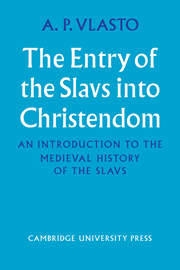Book contents
Summary
The Roman Empire was destined to give birth to two Christian civilisations, one Latin and one Greek. However trivial the differences might seem at first and however long it might take for East and West each to realise and admit it, ineluctable divergence in way of life, above all in intellectual style, was bound to lead in the long run to a point of mutual incomprehension and hostility. For it is unity of style which makes and maintains a civilisation.
Justinian's restored empire in the sixth century had been an artificial construction which had rapidly crumbled, not the least owing to the incursions of the Slavs, but also through the Lombard domination of the greater part of the Italian peninsula. Any further attempt at such a restoration from the Eastern side was finally put out of court in the seventh century by Moslem command of Mediterranean communications. The following hundred or so years during which the Iconoclast troubles preoccupied the remnants of the Byzantine Empire (730–843) was heavy with consequences for the whole future shape of Europe. During the previous century the Empire had succeeded in denying Islam a foothold on the European mainland at the price of an enormous loss of territory, with all its Christian population, and of grave exhaustion of its energies. Now it plunged into the further exhausting internal strife over images, incidentally providing the Papacy with a perpetual grievance by detaching Illyricum and South Italy from the jurisdiction of popes who refused to acquiesce in the Imperial iconoclast policy.
- Type
- Chapter
- Information
- The Entry of the Slavs into ChristendomAn Introduction to the Medieval History of the Slavs, pp. 308 - 317Publisher: Cambridge University PressPrint publication year: 1970

